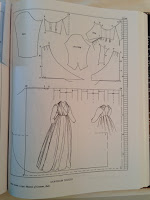For my late June Our of Your Comfort Zone challenge, I decided to finally create a long planned transitional gown from 'The Cut of Women's Clothes' by Norah Waugh. It's the open robe gown, and is a period I have not yet done, and I was quite nervous to attempt this era when the late 18th century (Georgian) waistline is transitioning to the early 19th century waistline (Regency). I created and finished this gown in early-mid July.
First, the finished gown, worn for the first time at last Saturday's Jane Austen Ball at Gadsby's Tavern:
 |
| Late 1790's Open Robe Gown by TheLadyDetalle |
I created a Pinterest board for all my research on late 1790's gowns, which can be found here. This is the picture from the book that I based this on:
 |
| Open Robe from 'The Cut of Women's Clothes' by Norah Waugh |
The Challenge: Out of Your Comfort Zone - Create a garment from a time period you haven’t done before, or that uses a new skill or technique that you’ve never tried before.
For this challenge, I drafted a transitional late 1790's open robe gown from the book, 'The Cut of Women's Clothes' by Norah Waugh.
Fabric: A Jomar find: I used about 10+ yards of a (I believe) silk cotton blend with copper sequin spangles stripes - the fabric was a SUPER bargain, and I had to cut around a lot of flaws, holes and ripped edges to make my full open robe dress with train.
Pattern: No pattern. I drafted this by looking at the picture from 'The Cut of Women's Clothes' (I did not scale the pattern, I simply drew general shapes by looking at the shapes in the book, creating two muslins before I was happy with the fit). I used my S&S crossover gown sleeve as the basis of my sleeves, and then drafted/drew an entirely different sleeve to fit my drafted bodice.
Year: Transitional. Late 1790's, probably about 1798-1799.
Notions: Thread, pins to close.
How historically accurate is it? I would say it's very historically accurate. They had similar fabric at the time, and they had metal sequins and the like (these are metallic but not metal) but it passes the close up check. I hand sewed everything that is visible (binding, hem, sleeve binding, etc.) but machine sewed the bodice together and the skirt panels. I hand braided the belt and hand sewed the edges together. The braided belt is 3 strips of the sequin spangled stripe, cut out then braided together.
Hours to complete: A lot! I put this together over about 4 days of stay-cation sewing days, sewing about 8-10 hours a day. Mainly a lot of the time was taken up in drafting/drawing my muslin mock-ups, trying on and making changes until I was good with the fit. The fit was quite challenging as I'm not used to the lower waistline of the transitional time, which was between the high, high waistlines of the early Regency period and the lower waistlines (true waist) of the Georgian period. It was a challenge coming up with in-between look of the late 1790's!
First worn: At the Jane Austen Ball at Gadsby's Tavern last Saturday! My friend from Learning to Costume bought similar fabric at the same time, and we made up our dresses to wear together on Saturday (mine 1798-1799 and hers 1805).
Total cost: So I paid a ridiculously LOW price for my 13 1/2 yards of fabric: $5. It was seriously flawed like crazy with holes, tears, rips and flaws (and the cutter discouraged me from buying any) but the fabric was gorgeous and just spoke to me about becoming a flow-y dress with a train, that I decided to take a chance! I lined the bodice with a purple silk that was about $5 a yard, and I used less than a yard.
 |
| TheLadyDetalle & LearningToCostume in their 'matching' fabric dresses |
No comments:
Post a Comment